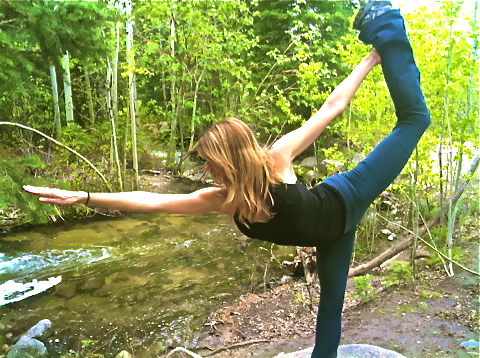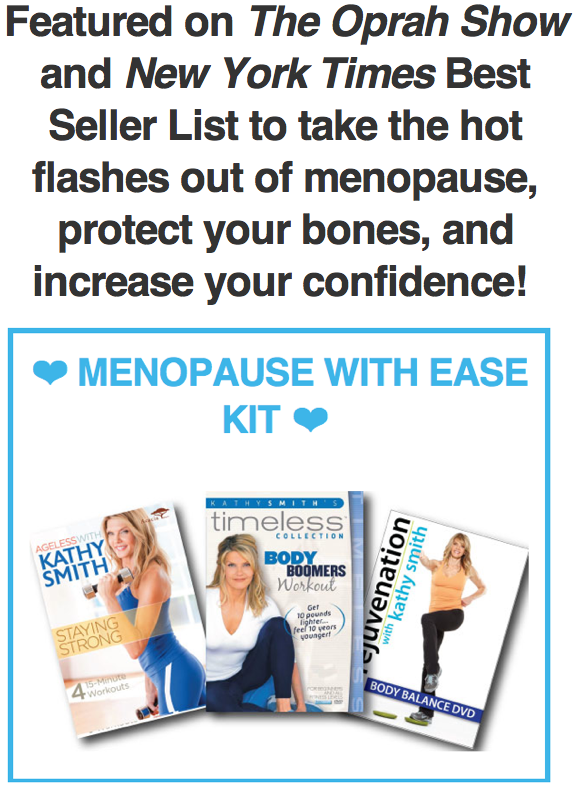For part 2, click here
I’m 63 and feeling better than ever! To celebrate this time of life, I made a simple ABC guide on how to manage symptoms of perimenopause and show you how this stage of life can be a positive transformational period. From hot flash remedies to spicing up the bedroom fun, feel free to indulge in a few of my favorite tricks!
A- Active Lifestyle
When I was younger, almost every workout was an all-out push. Now, I allow more recovery time between strenuous workouts and I practice what’s called “active recovery”, involving gentler, low-intensity exercise on those days. While I do something active every day, frequently it’s a low-stress activity such as walking or yoga, aimed at getting my blood circulating and staying limber.
B- Bedroom Fun
There’s hardly a menopausal symptom that exercise doesn’t improve: From low libido to fatigue to mental alertness to insomnia—exercise is my candidate for a wonder drug. Sensual movement patterns are the vehicle that allow the body to “flow” — to move to its own rhythm and current. These movements create harmony and vitality by uniting the rhythms of the body and breath.
Try out this 8-minute stretch from my Flex Appeal DVD to lubricate your joints and improve the flow of energy throughout your body.
C- Cardiovascular exercise
Keeping up a walking program during perimenopause and menopause will help strengthen the heart and boost your mood. Adding intervals to your routine can not only blast away belly fat, but also break up the monotony and make the exercise more fun!
Try this interval training workout:
- Start with a 4-minute walking warm-up at a steady state pace.
- Next, do a 90 second push, where you’re walking faster and with more intensity (on a scale of 1 to 10, 10 being impossibly hard, you should be at a 7 or 8).
- Slow it back down to a moderate pace for a 90-second recovery.
- Repeat that cycle: 90 seconds at a level 7, and 90 second recovery.
- Next, do a 30-second push. This one’s shorter, so really go for broke, and pump it up to an 8 or even a 9. Then recover for 90 seconds.
- Repeat the full cycle a total of 5 times, and finish off with a brief cool down.
D- Dry Vagina
During this stage of life, low estrogen causes makes your vagina less moist. To relieve vaginal dryness, load up on Vitamin E! This tried and true simple supplement helps with vaginal dryness, hot flashes and protects your heart. Studies found that vitamin E at doses of 50-400 IU per day effectively increased blood supply to the vaginal wall and improved menopausal symptoms. Remember, you need four weeks of taking vitamin E daily to experience the effects. To amp up your Vitamin E supply, add in some nuts, spinach, or avocados into your daily meals.
E- Estrogen
The main feature of menopause is the fluctuations and eventual decline of estrogen, one of several hormones (including progesterone and testosterone) that are manufactured in the ovaries. Estrogen is the hormone that makes you feel feminine. I think of estrogen as a woman’s life force, which means having too little can make you feel out-of-sorts, sluggish, and depressed.
Some effects of low estrogen are:
- Stimulated appetite, which can cause weight gain
- Drop in serotonin levels, which can lead to mood swings and unpredictable behavior
- Unstable themoregulatory control in the body, causing hot flashes and night sweats
- Decreasing bone density, which leads toto osteopenia and osteoporosis
- Causes the vagina to become shorter and narrower, and lose some of its elasticity
- Blood supply and secretions decrease, and the vagina doesn’t lubricate as well during sex
- The once succulent inner walls may become tissue-thin and dry. Intercourse can become uncomfortable or even painful. The thinner vaginal walls are also more vulnerable to infection
Causes the vagina to become shorter and narrower, and lose some of its elasticity. Blood supply and secretions decrease, and the vagina doesn’t lubricate as well during sex. The once succulent inner walls may become tissue-thin and dry. Intercourse can become uncomfortable or even painful. The thinner vaginal walls are also more vulnerable to infection.
Menopause is highly variable, and everyone’s experience of it is likely to be unique. Some of the symptoms often associated with this transition are listed below. Those toward the top of the list are more common. Some of the symptoms associated with a drop in estrogen are:
- Skipped periods
- Heavier or lighter periods
- Increased PMS
- Hot flashes (also called flushes)
- Vaginal dryness
- Mood swings
- Night sweats
- Restless sleep
- Lack of concentration
- Loss of libido
- Irritability
- Muscle aches and pains
- Infections of the genitourinary system • Crawling skin
- Fatigue
- Headaches
- Memory loss
- Heart palpitations
The loss of reproductive levels of estrogen can have profound long-term effects on the body, including: heart disease, osteoporosis and loss of cognitive function.
Targeting lifestyle changes and nutraceuticals can help minimize your menopausal symptoms.
- Avoid caffeine
- Eat more soy
- Avoid gluten and shift your diet to include more fruits and vegetables and lean proteins
- Add flax seeds to your meal
- Adjust intensity of workouts
- Acupuncture
- Take 400 mg. of magnesium daily
[mwi_product sku=”MWE001″ title=”true” title_tag=”h2″ desc=”true” img=”true” img_width=”200″ price=”true” type=”add” btn_color=”blue” btn_link=”button” cols=”3″/]
F- (Hot) Flashes
The first line of defense against hot flashes is to address the triggers. Hot flashes may be triggered by a variety of factors, although sometimes they seem to occur for no reason at all. Keeping a hot-flash diary for a few weeks may help you identify at least a few of your triggers and, with luck, help you reduce the frequency of your flashes.
Common hot flast triggers include:
- A warm car, hot shower or bath, sauna, warm bed, or any warm environment
- Stressful situations
- Heavy or restrictive clothing
- Confined spaces
- Spicy ethnic foods, or hot meals that might raise your body temperature, like hot soup
- Coffee and tea drinks (even hot decaffeinated drinks)
A few tips for cooling off are:
- Dressing in layers
- Switching from steaming lattés to iced herbal drinks
- Using breathable 100% cotton bedding and sleepwear
- Paced breathing (see below)
- Accupuncture
- Vitamin E
- Femal — an herbal remedy and pollen extract
- Rhubarb
- Reducing your stress through progressive relaxation, yoga, meditation, or other means (all are discussed in chapter 10 of Moving Through Menopause)
Meanwhile, inventive women have developed dozens of strategies for keeping their cool. Portable spritz fans, for instance, combine a spritzer bottle with a handheld fan. Some women install a ceiling fan over their bed. One woman I know soaks her socks in water before sleeping in them…the water evaporates as she sleeps and helps keep her cool. In general, turning down the thermostat will help, especially at night.
Lowering stress is one of the best safeguards against midlife problems, and yoga provides the perfect combination of techniques to accomplish the job. In fact, yoga breathing techniques may even help with hot flashes. In one study, researchers at the Lafayette Clinic in Detroit found that paced respiration (similar to yogic breathing) reduced hot flashes by up to 40 percent.

G- Good Health
However varied women’s experience of menopause may be, however complex the physiologic changes, I believe it all comes down to this simple formula: The healthier you are, the easier your menopause will be.
Working out is great, but if you really want results — it’s important to balance your hormones naturally and receive ongoing support, motivation, and an energized plan to stay on track. Join ReShape and get daily workout videos customized for you, 100+ fat burning recipes, audio walking workouts to blast belly fat, plus Kathy as your coach! Learn more at www.kathysmithreshape.com
H- Hormone Replacement Therapy
Hormone replacement can relieve some of the worst short-term symptoms of menopause. For women who’ve reached the end of their rope because of hot flashes and mood swings, HRT can be a godsend. On the other hand, it’s not an exact science. Tinkering with your hormones to find the right balance may be a trial-and-error process, and some women don’t find the relief they seek. In addition, there can be side effects and possible long-term risks of taking these drugs. Some doctors feel that most of the side effects can be avoided by taking “bioidentical” hormones (those identical to what our body produces) and by avoiding oral hormones in favor of a patch. The real gray area has to do with long-term effects of HRT—the risks and the benefits. Currently, most doctors feel HRT provides solid defense against osteoporosis and may offer some protection against heart disease, at least in healthy women. Others are optimistic about HRT’s potential for preventing or delaying Alzheimer’s disease. However, the jury’s still out on much of this. New findings are being published every day, which is why it’s so important to find a doctor who is up on the latest research.
In Chapter 12 of Moving Through Menopause, I provide a clear understanding of both sides of the issue so that you can have an informed discussion with your doctor and feel that you asked all the right questions.
I- Information Gathering
It’s not easy to gather accurate information! There’s a lot of information out there and it can be very confusing for two reasons: First, women’s experiences vary widely; and second, the standard medical wisdom is changing constantly as new research comes in. Providing information and a helping you sort out all of the confusing data is exactly what I hope to provide with my book, Moving Through Menopause.
Also, Dr. Sara Gottfried is on the leading edge of optimizing hormones at any age. Her book, The Hormone Cure, can help you reclaim balance, sleep, sex drive and vitality naturally.
 J- Journaling
J- Journaling
I’ve kept a journal off and on throughout my life. I notice I tend to do it during especially emotional periods. It’s a great way to relieve anxiety in the moment, and it’s also a good way to track your personal growth over time.
K- Kegel Exercises
Kegels are exercises that tone and strengthen the pubococcygius, or PC muscle—the muscle surrounding the opening of the vagina. A strong PC muscle is vital to the health of the reproductive organs. Like any other muscle in the body, the PC muscle needs regular exercise to remain firm, especially after childbirth or menopause. When done correctly, “Kegeling” can alleviate up to 90 percent of stress incontinence and heighten pleasure and sensitivity during intercourse.
Try this simple kegel exercise:
Squeeze for one second, relax for one second, and squeeze again. Squeeze and release ten times, just slowly enough that you can still distinguish the contraction from the release.
L – Lifestyle measures
While not necessarily a substitute for hormone therapy or other medication, switching up your lifestyle measures are the the best starting point for everyone. Here are ten to start with:
- Minimize caffeine
- Cut back on gluten
- Eat more edamame and whole soy
- Get outdoors
- Drink green tea
- Add flaxseed and fish oil to your protein shakes
M- Mood Swings
You probably already know about the importance of limiting your intake of sugar, caffeine, and salt, but the need is even greater when you’re on that hormonal trampoline preceding menopause. Cutting back on these much overdone dietary crutches will help you avoid mood swings, weight gain and insomnia—as well as long-term threats like hypertension and bone loss.
Click here for Part 2 of The ABCs of Menopause! In the meantime, grab your copy of my Menopause With Ease Kit today!
The ABCs Of Menopause: Part 1






Kathy, I agree whole-heartedly with you that the healthier you are, the easier your menopause will be. I am only 57 but post-menopausal for a few years already and I exercise everyday and have for the past 10 years and have never felt better. My pre and peri-menopausal years were not bad at all. And I feel great!
Hi, I am 46 and because of a suspicious growth on my right ovary and precancer cells in my uterus, I just had a laprascopic hysterectomy with bilateral oophorectomy. This threw me immediately into menopause. Will it be different or more severe for me?